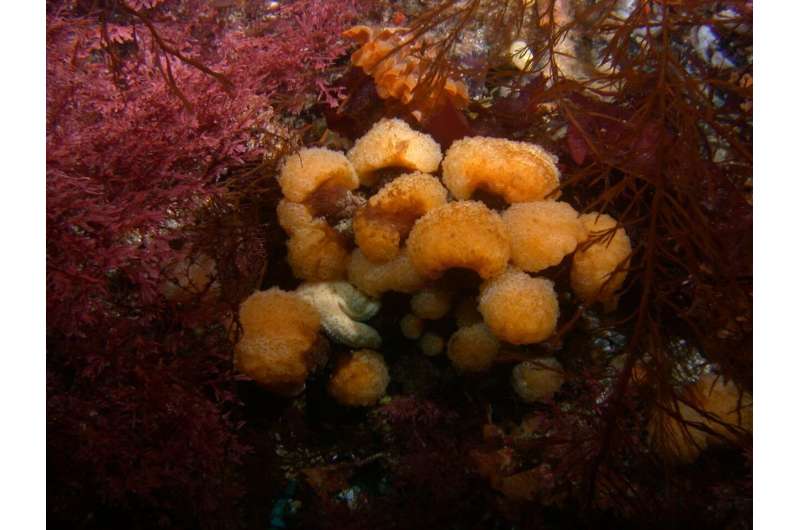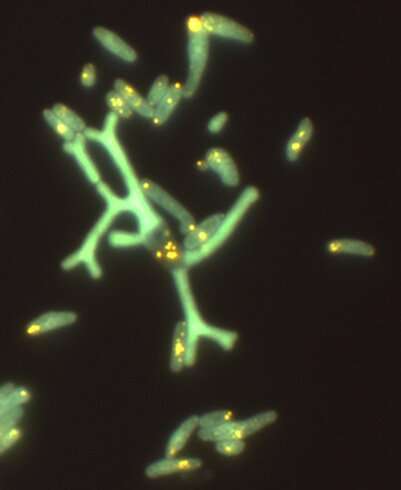Study reveals key finding about microbiome of anticancer compound-producing marine invertebrate

Could the cure for melanoma—the most dangerous type of skin cancer—be a compound derived from a marine invertebrate that lives at the bottom of the ocean? A group of scientists led by Alison Murray, Ph.D. of the Desert Research Institute (DRI) in Reno think so, and are looking to the microbiome of an Antarctic ascidian called Synoicum adareanum to better understand the possibilities for development of a melanoma-specific drug.
Ascidians, or 'sea squirts,' are primitive, sac-like marine animals that live attached to ocean-bottoms around the world, and feed on plankton by filtering seawater. S. adareanum, which grows in small colonies in the waters surrounding Antarctica, is known to contain a bioactive compound called 'Palmerolide A' with promising anti-melanoma properties—and researchers believe that the compound is produced by bacteria that are naturally associated with S. adareanum.
In a new paper published this month in the journal Marine Drugs, Murray and collaborators from the University of South Florida, the Los Alamos National Laboratory, and the Université de Nantes, France, present important new findings measuring palmerolide levels across samples collected from Antarctica's Anvers Island Archipelago and characterizing the community of bacteria that make up the microbiome of S. adareanum.
"Our longer-term goal is to figure out which of the many bacteria within this species is producing palmerolide, but to do this, there is a lot we need to learn about the microbiome of S. adareanum," Murray said. "Our new study describes many advances that we have made toward that goal over the last few years."
In 2008, Murray worked with Bill Baker, Ph.D., of the University of South Florida, and DRI postdoctoral researcher Christian Riesenfeld, Ph.D., to publish a study on the microbial diversity of one individual S. adareanum. Their new study builds upon this research by characterizing the microbial diversity of 63 different individuals that were collected from around Anvers Island.

Their results identify a what the researchers call the 'core microbiome' of the species—a common suite of 21 bacterial taxa that were present in more than 80 percent of samples, and six bacterial taxa that were present in all 63 samples.
"It is a key 'first' for Antarctic science to have been able to find and identify this core microbiome in a fairly large regional study of these organisms," Murray said. "This is information that we need to get to the next step of identifying the producer of palmerolide."
Another 'first' for Antarctic science, and for the study of natural products in nature in general, was a comparison of palmerolide levels across all 63 samples that showed the compound was present in every specimen at high (milligram per gram specimen tissue) levels, but the researchers found no trends between sites, samples, or microbiome bacteria. Additional analysis looking at the co-occurrence relationships of the taxa across the large data set showed some of the ways that bacteria are interacting with each other and with the host species in this marine ecosystem.
"The microbiome itself is unique in composition from other ascidians, and seems to be pretty interesting, with a lot of interaction," Murray said. "Our study has opened the doors to understand the ecology of this system."
From the assemblage of bacteria that the researchers have identified as making up the core microbiome of S. adareanum, they next hope to use a genomics approach to finally be able to identify which of the bacteria are producing palmerolide—an important and needed advancement toward the development of a melanoma treatment.
"It would be a really big deal to use this compound to develop a drug for fighting melanoma, because there are just so few drugs at the moment that can be used to treat it," Murray said. "If we can identify the bacteria that produce this chemical, and with its genome understand how to cultivate it in a laboratory setting, this would enable us to provide a sustainable supply of palmerolide that would not rely on harvesting wild populations of this species in Antarctica."
More information: Alison E. Murray et al, Uncovering the Core Microbiome and Distribution of Palmerolide in Synoicum adareanum Across the Anvers Island Archipelago, Antarctica, Marine Drugs (2020). DOI: 10.3390/md18060298




















